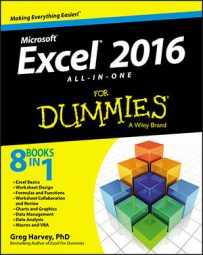Excel 2016 allows you to consolidate data from different worksheets into a single worksheet. Using the program's Consolidate command button on the Data tab of the Ribbon, you can easily combine data from multiple spreadsheets.
For example, you can use the Consolidate command to total all budget spreadsheets prepared by each department in the company or to create summary totals for income statements for a period of several years. If you used a template to create each worksheet you're consolidating, or an identical layout, Excel can quickly consolidate the values by virtue of their common position in their respective worksheets. However, even when the data entries are laid out differently in each spreadsheet, Excel can still consolidate them provided that you've used the same labels to describe the data entries in their respective worksheets.
Most of the time, you want to total the data that you're consolidating from the various worksheets. By default, Excel uses the SUM function to total all the cells in the worksheets that share the same cell references (when you consolidate by position) or that use the same labels (when you consolidate by category). You can, however, have Excel use any of other following statistical functions when doing a consolidation: AVERAGE, COUNT, COUNTA, MAX, MIN, PRODUCT, STDEV, STDEVP, VAR, or VARP.
To begin consolidating the sheets in the same workbook, you select a new worksheet to hold the consolidated data. (If need be, insert a new sheet in the workbook by clicking the Insert Worksheet button.) To begin consolidating sheets in different workbooks, open a new workbook. If the sheets in the various workbooks are generated from a template, open the new workbook for the consolidated data from that template.
Before you begin the consolidation process on the new worksheet, you choose the cell or cell range in this worksheet where the consolidated data is to appear. (This range is called the destination area.) If you select a single cell, Excel expands the destination area to columns to the right and rows below as needed to accommodate the consolidated data. If you select a single row, the program expands the destination area down subsequent rows of the worksheet, if required to accommodate the data. If you select a single column, Excel expands the destination area across columns to the right, if required to accommodate the data. If, however, you select a multi-cell range as the destination area, the program does not expand the destination area and restricts the consolidated data just to the cell selection.
If you want Excel to use a particular range in the worksheet for all consolidations you perform in a worksheet, assign the range name Consolidate_Area to this cell range. Excel then consolidates data into this range whenever you use the Consolidate command.
When consolidating data, you can select data in sheets in workbooks that you've opened in Excel or in sheets in unopened workbooks stored on disk. The cells that you specify for consolidation are referred to as the source area, and the worksheets that contain the source areas are known as the source worksheets.
If the source worksheets are open in Excel, you can specify the references of the source areas by pointing to the cell references (even when the Consolidate dialog box is open, Excel will allow you to activate different worksheets and scroll through them as you select the cell references for the source area). If the source worksheets are not open in Excel, you must type in the cell references as external references, following the same guidelines you use when typing a linking formula with an external reference (except that you don't type =). For example, to specify the data in range B4:R21 on Sheet1 in a workbook named CG Music - 2014 Sales.xlsx as a source area, you enter the following external reference:
'[CG Music – 2014 Sales.xlsx]Sheet1'!$b$4:$r$21
Note that if you want to consolidate the same data range in all the worksheets that use a similar filename (for example, CG Music - 2012 Sales, CG Music - 2013 Sales, CG Music - 2014 Sales, and so on), you can use the asterisk (*) or the question mark (?) as wildcard characters to stand for missing characters as in
'[CG Music - 20?? Sales.xlsx]Sheet1'!$B$4:$R$21
In this example, Excel consolidates the range A2:R21 in Sheet1 of all versions of the workbooks that use "CG - Music - 20" in the main file when this name is followed by another two characters (be they 12, 13, 14, 15, and so on).
When you consolidate data, Excel uses only the cells in the source areas that contain values. If the cells contain formulas, Excel uses their calculated values, but if the cells contain text, Excel ignores them and treats them as though they were blank (except in the case of category labels when you're consolidating your data by category).

